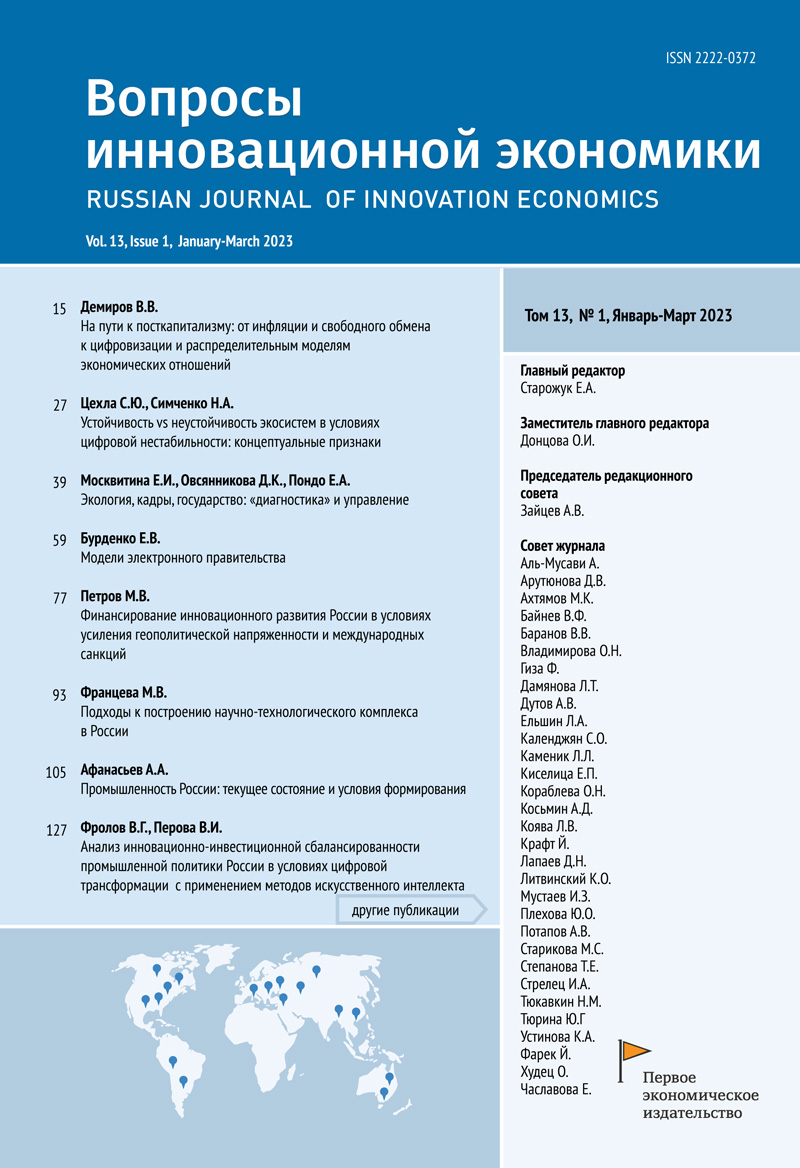Modeling of interregional integration processes: cluster approach amidst digitalization
- 作者: Buletova N.E.1, Gubin A.M.1
-
隶属关系:
- Kutafin Moscow State Law University (MSAL)
- 期: 卷 13, 编号 1 (2023)
- 页面: 521-534
- 栏目: Articles
- URL: https://journals.eco-vector.com/2222-0372/article/view/608125
- DOI: https://doi.org/10.18334/vinec.13.1.117060
- ID: 608125
如何引用文章
详细
Substantiation of options for the formation or development of interregional integration processes in the new realities of foreign economic cooperation and capital flows, threats to economic security and national sovereignty is an urgent task for the adjustment of state economic policy at the federal and regional levels of executive power and leading regional organizations, as well as large national corporations. Rethinking the cluster approach to integration processes allows not only to clarify the classification of clusters relevant for the level of the regional economy, but also to present the authors' version of the classification of interregional interaction models that have an artificial nature associated with the initiation and management of such processes by the regional executive authorities. The importance of standardization of cluster creation processes by analogy with the system of international, national and industry standards for project activity determines the prospects for formalizing the stages of the cluster life cycle and methods of managing its movement from initiation to completion.The presented models' classification is based on the economic systems' typology in the constituent entities of the Russian Federation with division into agricultural, industrial and service types. This makes it possible to substantiate the directions and results of integration processes related to the clusters' creation, a network form of business and obtaining synergetic effects from such forms in the regional economy.
作者简介
Natalya Buletova
Kutafin Moscow State Law University (MSAL)
Email: buletovanata@gmail.com
Aleksandr Gubin
Kutafin Moscow State Law University (MSAL)
Email: AMGUBIN@msal.ru
参考
- Булетова Н.Е., Скачкова С.А., Павлова И.М. Оценка вклада аграрных регионов России в инновационное развитие экономики (на примере ЮФО) // Экономика сельского хозяйства России. – 2021. – № 12. – c. 11-18.
- Губин А.М. Концептуальные основы экономической интеграции в условиях глобализации и устойчивого развития региональной экономки // Экономика, предпринимательства и право. – 2022. – № 10. – c. 2601-2622.
- Материалы Росстата «Отраслевая структура валовой добавленной стоимости субъектов РФ в 2020 году». [Электронный ресурс]. URL: https://rosstat.gov.ru/storage/mediabank/VRP_OKVED2_.xlsx (дата обращения: 27.12.2022г.).
- Бек М.А., Бек Н.Н., Бузулукова Е.В. Методология исследования сетевых форм организации бизнеса. / коллект. моногр. под науч. ред. М. Ю. Шерешевой; Нац. исслед. ун-т «Высшая школа экономики». - М.: Изд. дом Высшей школы экономики, 2014. – 446 c.
- Портер М.Э. Конкуренция. - М.: Издат. дом «Вильямс», 2001. – 495 c.
- Руководство PMBOK: 6-е издание. / США, Newtown Square. - A: Project Management Institute, 2017.
- Сборник Росстата «Регионы России. Социально-экономические показатели – 2022». [Электронный ресурс]. URL: https://rosstat.gov.ru/folder/210/document/13204 (дата обращения: 26.12.2022г.).
- Третьяк В.П., Лякина М.А. Цифровая платформа – продукт квазиинтегрированных систем // Азиатско-тихоокеанский регион: Экономика, политика, право. – 2020. – № 1. – c. 61-73.
- Шерешева М.Ю. Формы сетевого взаимодействия компаний. - М.: ГУ-ВШЭ, 2010. – 339 c.
- Buletova N.E., Stepanova E.V. Structural differences of economies of different developmental types: Assessments and effective ranking on a global basis // International Journal of Applied Engineering Research. – 2017. – № 22. – p. 12554-12563.
- Grandori A., Soda G. Inter-firm Networks: Antecedents, Mechanisms and Forms // Organization Studies. – 1995. – № 2. – p. 183-214.
- Johanson J. Firms in Networks: A New Perspective on Competitive Power. Uppsala, 1995. [Электронный ресурс]. URL: https://www.goodreads.com/book/show/2775130-firms-in-networks (дата обращения: 23.12.2022г.).
- Chesbrough H.W., Teece D.J. When is virtual virtuous? Organizing for innovation // Harvard business review. 1996. Jan.-Febr. P. 65-73. URL: https://www.researchgate.net/publication/299201255_Organizing_for_innovation_When_is_virtual_virtuous (дата обращения – 23.12.2022г.)
- Mattson Lars Gunnar. Management of Strategic Change in a ‘Markets-as Networks’ Perspective // The Management of Strategic Change / ed. by Andrew M. Pettigrew. Oxford; New York: Basil Blackwell, 1987. URL: https://openlibrary.org/books/OL2386625M/The_Management_of_strategic_change (дата обращения – 23.12.2022г.)
- Monteverde K., Teece D.J. Supplier Switching Costs and Vertical Integration in the Automobile Industry // The Bell Journal of Economics. – 1982. – № 1. – p. 206-213.
补充文件








